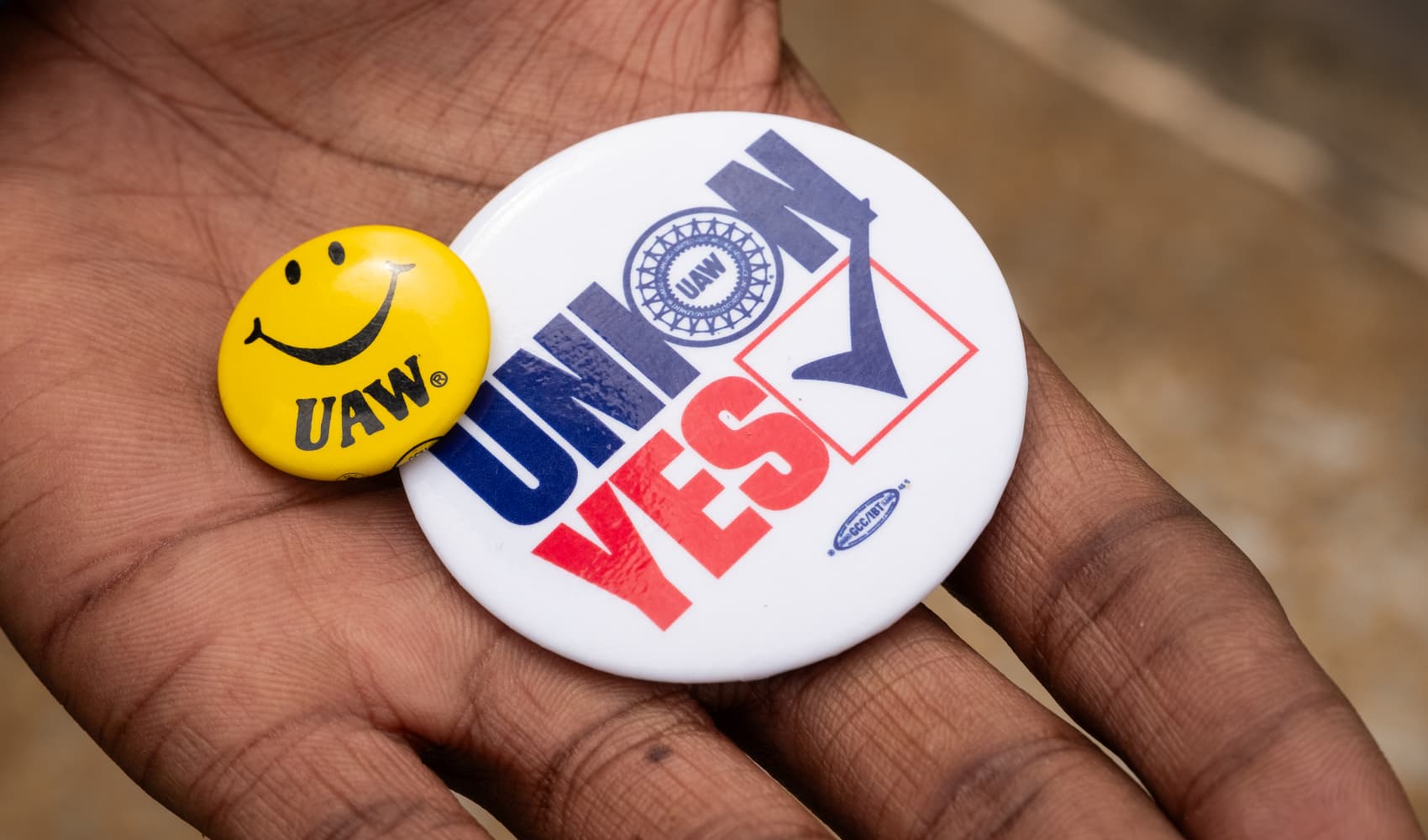
- The Federal Reserve is anticipating multiple rate hikes in 2022 as the economy strengthens and concerns about inflation remain central to monetary policy.
- Many forms of inflation may prove short-lived and ebb with supply chain improvements next year, but wage inflation can be stickier.
- Fed Chair Jerome Powell cited wages as a key inflation signal to watch in 2022, and there are fears of what is known as a wage-price spiral, in which rising pay feeds rising prices. Some economists say it is already here.
More than half of U.S. states are raising minimum wages next year, but employers are moving even faster on pay increases.
Salary budget increases set by employers for 2022 are higher than they have been in at least a decade, with 99% of employers planning raises and many planning increases of 5% to 6% in 2022, according to compensation consulting firm surveys. Deloitte's fourth quarter CFO Signals survey funds 97% of CFOs saying that labor costs will increase substantially in 2022.
Top companies are aggressively fighting for talent and fighting their own employees' demands for higher pay to fight inflation. Apple is reportedly even paying rare $180,000 stock bonuses to keep engineers for going to tech rivals.
Get Boston local news, weather forecasts, lifestyle and entertainment stories to your inbox. Sign up for NBC Boston’s newsletters.
But while the Federal Reserve says wage inflation is a factor to monitor in 2022, it is not a primary inflation driver yet.
Some economists aren't as sure as the central bank that rising pay isn't already contributing to what is known as a wage-price spiral, a labor market dynamic in which wage inflation leads to higher prices, and higher prices lead to calls for even higher pay.
"It is here," said Lynn Reaser, chief economist and professor of economics at Point Loma Nazarene University. "You've seen it in the restaurant industry, not only the price increases in the cost of serving meals from the ingredient side, but from the attempt to desperately recruit new workers, and restaurants passing it along to customers in the form of higher prices."
Money Report
Reaser says it is not only the restaurant industry, hard-hit by the pandemic, though. Manufacturers are testing the waters for how much they can raise prices, and producers supplying grocery stores are citing labor costs as one of the driving them to consider higher prices.
Producer prices rose at the fastest rate on record in November.
"A wage-price spiral has started," wrote Sung Won Sohn, professor of finance and economics at Loyola Marymount University and head of SS Economics.
In a period when businesses have no problem hiking prices, "the spiral, once begins, it is hard to stop," he wrote, citing data from the Atlanta Fed on how higher labor costs are being passed along to consumers with little resistance.
Fed Chair Powell's growing focus on wages
Federal Reserve Chair Jerome Powell is speaking more about the wage inflation issue, and the Fed is saying that its actions are now tied more closely to it.
"If you look at the state of the economy ... the strength of demand, the strength of just overall demand, the strength of demand for labor, look at inflation, look at wages ... moving forward the end of our taper by a few months is really an appropriate thing to do," Powell said after the most recent FOMC meeting in mid-December, but he stopped short of saying there is a wage-price spiral.
"Wages have also risen briskly, but thus far, wage growth has not been a major contributor to the elevated levels of inflation" he said. "We are attentive to the risks that persistent real wage growth in excess of productivity could put upward pressure on inflation," he said.
There are multiple factors at play in the wage dynamic, some which may ease in the future, though not all.
Partly at fault in the wage inflation, Reaser says, are restrictions on immigrant workers that shut off a significant escape valve for wage pressure and competition for existing workers. It is a factor employers in the technology, health care, leisure and construction sectors face, and at all levels of pay, low- middle- and high-income.
The large safety net provided by the government during the pandemic kept people on the sidelines, and the Great Resignation led more Americans to look at their work-life balance and decide to retire.
Labor shortages are not likely to improve soon, with the jump in retirement during the pandemic.
Sohn noted that even before the pandemic, the growth of the U.S. labor force has been slowing, and it could get worse. During the 1980s, the labor force grew 1.6% per year. During the current decade, he says "it could approach zero."
"These will mitigate to some extent, but wage inflation is now the dominant risk," Reaser said.
She worries that some of the upward pressure at the lower end of the pay scale will push higher brackets of pay upwards as well. "Maybe not all the way up to management, but mid-income, as their margin over less-skilled employees will have shrunken in terms of wages," Reaser said. "There will be pressure on those people to ask for larger wage increases so they can keep their margin over lower pay workers."
The vicious cycle of the wage-price spiral
"It is a vicious cycle," said Gad Levanon, head of the Conference Board's Labor Markets Institute.
The wage-price spiral is self-perpetuating, both feeding off each other and at every stage going higher because wages have to compensate for higher inflation, and then faster wages lead to further higher inflation, and higher inflation impacts wages again.
Thirty-nine percent of companies responding to a recent Conference Board survey said inflation was a factor in salary budget increases for 2022. "That's a meaningful share," he said. "From conversations I have with HR and compensation professionals, they are definitely now talking more about cost of living adjustments than they did before. When we talked about COLA even six month ago, it was 'something we did in the 70s and 80s.'"
Wages impacting prices and prices impacting wages is clearly happening, Levanon said, and has been underway for a while already. "Now, more than any other time in recent decades," he said.
But Levanon says it is not clear whether the wage inflation is divorced from the other determinants of inflation, which may ease in the coming year, and imply it will spiral out of control. "There are a lot of other determinants of wages and inflation, such as the supply chain, and what will happen with it in 2022, and how fast demand grows. As well as how many people come back into the labor market," he said.
Powell stressed that the median inflation projection of FOMC participants falls from 5.3% this year to 2.6% next year, and that trajectory is "notably higher" than projected in September.
"So far, we don't see, wages are not a big part of the high inflation story that we're seeing," he said.
Reaser says even if supply chain issues are sorted out in the coming year, the problem she sees is that inflation has migrated strongly over to the wage side already, and it is going to be a whole other dynamic the Federal Reserve faces in 2022.
"Workers will be seeing and believing inflation will be staying higher and the risk the Fed has always guarded against was that inflationary expectations become unanchored, and certainly, they've started to become unanchored. That sets off demand for larger wage increases on the part of all workers and that starts a wage price spiral," she said.
If the economy has 4 % to 5% inflation, that is not the end of the world, Levanon said, but for the Fed it is a major issue threatening what it has tried to accomplish in recent decades in anchoring inflation expectations at a lower level.
"I think the biggest risk is that expectations about inflation will continue to rise and the more they rise, the more difficult those expectations are to manage," Levanon said. "It was a hard-earned accomplishment for the Fed to able to anchor inflation expectations, and they are at risk of losing it."
CEOs and Wall Street are worried
Businesses are worried too. Wage inflation is taking a toll on CEO confidence, according to recent Business Roundtable data, and some Wall Street analysts are going into 2022 assessing stocks based on a company's ability to pass along the labor costs to customers.
"Wage inflation is the issue I would focus on," said Goldman Sachs chief U.S. equity strategist David Kostin in a recent CNBC interview. "That's a headwind that is going to persist," he said.
Not all companies will be able to continue to pass those cost increases on to customers without risking the loss of customers to competitors.
When costs were rising by 2% a year, customers didn't think very hard about shifting to other providers, but when price goes up by 5%-6% then they start to think twice about it, Levanon said. When prices are moving up so much faster than they used to it can lead to a general rethink and adjustment of business-to-business and business-consumer relationships.
And this wage dynamic is occurring during a longer period of lagging growth of productivity, pre-dating the pandemic, but becoming even more pronounced when wages are rising.
Profit margins of companies can be squeezed, but to the extent workers are not receiving the wage increases they demand, there could be even more churn in the labor force, more hiring and training costs, and quit rates staying elevated. Companies can offset wage inflation with price increases or productivity gains, but they can also be limited on both sides, and new productivity measures take time to enact.
"Executives you talk to are worried about the larger wages they have to offer, and talk about investing in new productivity measures, which will take some time. And they are trying to test the waters with price increases while they work on productivity gain measures," Reaser said.
Many companies which say they can't pay employees more are simply protecting current profits, according to Levanon. But it is likely the current wage dynamic will lead to a greater divide between the haves and have nots in the business world, with the more profitable and productive companies able to limit the cost increases and still lead their industries. If they don't pass on more costs to consumers they may not be as profitable, and that could lead to a bigger difference between the most productive and least productive firms.
'Persistently' higher wages
"Powell does not want to ring alarm bells, but he does have to bring some acknowledgment that wage pressures are becoming a much bigger part of the inflation picture," Reaser said. "And will have to be monitored even more closely. The risk is the Fed may have to be more aggressive in 2022 than previously communicated, with even more rate hikes than currently forecast."
Levannon, who is in favor of even more aggressive rate hike timing than the Fed has signaled, said Fed policy and communication will remains important in terms of "whether this will spiral or not. ... Having rates at zero is not the right thing to do."
Powell already retired the "transitory" definition of inflation from the Fed's vocabulary in 2021. In 2022, it may be "persistently" and wages which are the bigger semantic argument, with big repercussions for the economy.
"As you look forward, let's assume that the goods economy does sort itself out and supply chains get working again, and maybe there's a rebalancing back to services. ... But what that leaves behind is the other things that can lead to persistent inflation," Powell said after the recent FOMC meeting. "If you had something where wages were persistently -- real wages were persistently above productivity growth, that puts upward pressure on firms and they raise prices, it would take something that was persistent in material for that to happen. And we don't see that yet. But with the kind of hot labor market readings -- wages we're seeing, it's something that we're watching."






